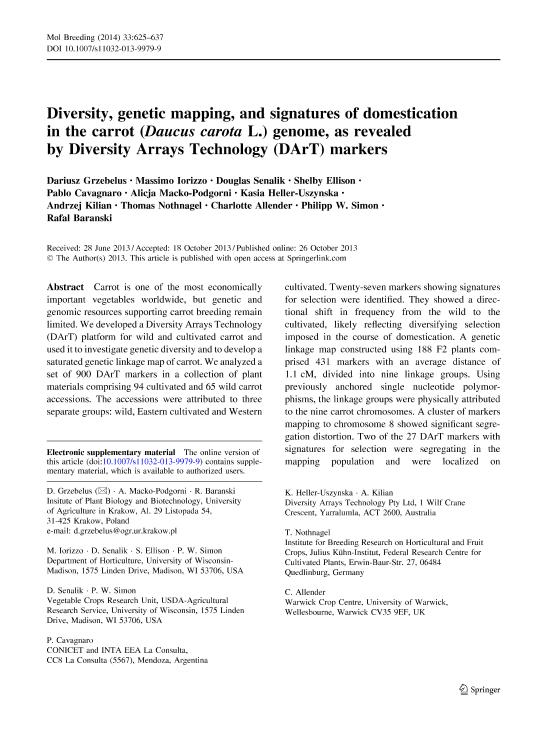Mostrar el registro sencillo del ítem
dc.contributor.author
Grzebelus, Dariusz

dc.contributor.author
Iorizzo, Massimo

dc.contributor.author
Senalik, Douglas
dc.contributor.author
Ellison, Shelby
dc.contributor.author
Cavagnaro, Pablo Federico

dc.contributor.author
Macko Podgorni, Alicja
dc.contributor.author
Heller Uszynska, Kasia
dc.contributor.author
Kilian, Andrzej
dc.contributor.author
Nothnagel, Thomas
dc.contributor.author
Allender, Charlotte
dc.contributor.author
Simon, Philipp W.
dc.contributor.author
Baranski, Rafal
dc.date.available
2020-03-19T18:52:47Z
dc.date.issued
2014-03
dc.identifier.citation
Grzebelus, Dariusz; Iorizzo, Massimo; Senalik, Douglas; Ellison, Shelby; Cavagnaro, Pablo Federico; et al.; Diversity, genetic mapping, and signatures of domestication in the carrot (Daucus carota L.) genome, as revealed by Diversity Arrays Technology (DArT) markers; Springer; Molecular Breeding; 33; 3; 3-2014; 625-637
dc.identifier.issn
1380-3743
dc.identifier.uri
http://hdl.handle.net/11336/100326
dc.description.abstract
Carrot is one of the most economically important vegetables worldwide, but genetic and genomic resources supporting carrot breeding remain limited. We developed a Diversity Arrays Technology (DArT) platform for wild and cultivated carrot and used it to investigate genetic diversity and to develop a saturated genetic linkage map of carrot. We analyzed a set of 900 DArT markers in a collection of plant materials comprising 94 cultivated and 65 wild carrot accessions. The accessions were attributed to three separate groups: wild, Eastern cultivated and Western cultivated. Twenty-seven markers showing signatures for selection were identified. They showed a directional shift in frequency from the wild to the cultivated, likely reflecting diversifying selection imposed in the course of domestication. A genetic linkage map constructed using 188 F2 plants comprised 431 markers with an average distance of 1.1 cM, divided into nine linkage groups. Using previously anchored single nucleotide polymorphisms, the linkage groups were physically attributed to the nine carrot chromosomes. A cluster of markers mapping to chromosome 8 showed significant segregation distortion. Two of the 27 DArT markers with signatures for selection were segregating in the mapping population and were localized on chromosomes 2 and 6. Chromosome 2 was previously shown to carry the Vrn1 gene governing the biennial growth habit essential for cultivated carrot. The results reported here provide background for further research on the history of carrot domestication and identify genomic regions potentially important for modern carrot breeding.
dc.format
application/pdf
dc.language.iso
eng
dc.publisher
Springer

dc.rights
info:eu-repo/semantics/openAccess
dc.rights.uri
https://creativecommons.org/licenses/by/2.5/ar/
dc.subject
CARROT
dc.subject
DART
dc.subject
DIVERSITY STRUCTURE
dc.subject
DOMESTICATION
dc.subject
LINKAGE MAPPING
dc.subject
SELECTION
dc.subject.classification
Bioquímica y Biología Molecular

dc.subject.classification
Ciencias Biológicas

dc.subject.classification
CIENCIAS NATURALES Y EXACTAS

dc.title
Diversity, genetic mapping, and signatures of domestication in the carrot (Daucus carota L.) genome, as revealed by Diversity Arrays Technology (DArT) markers
dc.type
info:eu-repo/semantics/article
dc.type
info:ar-repo/semantics/artículo
dc.type
info:eu-repo/semantics/publishedVersion
dc.date.updated
2020-03-18T20:37:37Z
dc.journal.volume
33
dc.journal.number
3
dc.journal.pagination
625-637
dc.journal.pais
Alemania

dc.journal.ciudad
Berlin
dc.description.fil
Fil: Grzebelus, Dariusz. Agricultural University of Kraków; Polonia
dc.description.fil
Fil: Iorizzo, Massimo. University of Wisconsin; Estados Unidos
dc.description.fil
Fil: Senalik, Douglas. University of Wisconsin; Estados Unidos
dc.description.fil
Fil: Ellison, Shelby. University of Wisconsin; Estados Unidos
dc.description.fil
Fil: Cavagnaro, Pablo Federico. Consejo Nacional de Investigaciones Científicas y Técnicas. Centro Científico Tecnológico Conicet - Mendoza; Argentina. Instituto Nacional de Tecnología Agropecuaria. Centro Regional Mendoza-San Juan. Estación Experimental Agropecuaria La Consulta; Argentina
dc.description.fil
Fil: Macko Podgorni, Alicja. Agricultural University of Kraków; Polonia
dc.description.fil
Fil: Heller Uszynska, Kasia. Diversity Arrays Technology; Australia
dc.description.fil
Fil: Kilian, Andrzej. Diversity Arrays Technology; Australia
dc.description.fil
Fil: Nothnagel, Thomas. Federal Research Center For Cultivated Plants; Alemania
dc.description.fil
Fil: Allender, Charlotte. University of Warwick; Reino Unido
dc.description.fil
Fil: Simon, Philipp W.. University of Wisconsin; Estados Unidos
dc.description.fil
Fil: Baranski, Rafal. Agricultural University of Kraków; Polonia
dc.journal.title
Molecular Breeding

dc.relation.alternativeid
info:eu-repo/semantics/altIdentifier/url/https://link.springer.com/article/10.1007/s11032-013-9979-9
dc.relation.alternativeid
info:eu-repo/semantics/altIdentifier/doi/http://dx.doi.org/10.1007/s11032-013-9979-9
Archivos asociados
